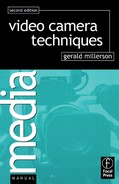You may want to shoot from an unusual angle for several reasons:
• To show details that are not normally visible (e.g. behind a statue).
• To get round obstructions that are blocking the shot.
• To shoot from a good but inaccessible vantage point.
• To present an overhead shot of the action – a ‘bird’s-eye’ view.
• To show a subject from below – a ‘worm’s-eye’ view.
• To achieve a dramatic effect.
Although today’s small video cameras are highly mobile and adaptable, extreme camera angles can still pose problems. Studio cameras with their larger zoom lens systems and viewfinders, are considerably less flexible.
Perhaps you can place the camera exactly where you need it. But situations do arise where it would be quite impracticable to support the camera and its operator safely. A remotely controlled camera guided from a distant picture monitor could be the answer. A tiny preset camera can be positioned in the most unlikely spots! However, it may hardly be worth the trouble and expense of these expedients for an odd shot or two.
The simple answer to many of these problems is to use a judiciously placed mirror; particularly where resources are limited. Instead of being tied up away from the general action, the camera can swing away in a moment to take normal direct shots.
Typical mirror shots include:
• Top shots of a demonstration table, using an overhead slung mirror.
• The camera, which is at its normal height, tilts up, and shoots via the mirror.
• A high-angle shot that would otherwise require a jib arm or camera crane.
• Level shots of a subject that is high up on a wall (statues, balconies, windows).
• Low-level and low-angle shots through a floor mirror or a periscope.
Mirrors do have their drawbacks. The picture will normally be reversed horizontally or vertically unless electronically corrected (line or field/frame reversal), or unless you shoot via a second corrective mirror.
Glass mirrors take time and skill to rig and adjust, and need to be surface-silvered to avoid degraded double images. Lightweight mirror-surfaced plastic is quite satisfactory for some purposes. If the mirror is small or distant, its coverage may be too restricted. Overhead mirrors often obstruct lighting.
Basic principles
The reflected image is reversed laterally (side-to-side) and appears as far behind the mirror as the subject is in front. Focus on the subject image, not on the mirror’s surface.

